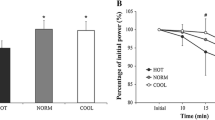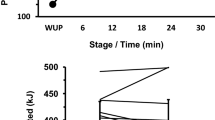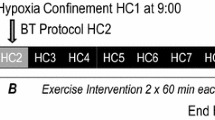Abstract
This study examined the role of skin temperature on self-selected exercise intensity (i.e., power output). Eight well-trained, male cyclists completed two 60 min self-paced cycling bouts during which they completed as much work as possible. Using a liquid-perfused suit, skin temperature (T Sk) was changed during the two trials such that T Sk either started hot and was cooled (H to C) or started cold and was heated (C to H) throughout exercise. Pre-exercise core temperatures (T C) and heart rates (HR) were similar between trials, while T Sk, thermal comfort and thermal sensation were higher in H to C. The change in T Sk was similar in magnitude during the two trials. Work completed was greatest in C to H, which was attributed to a higher initial power output. T C was similar between trials. HR was similar until 35 min had elapsed, after which it became lower in H to C. The perception of effort increased similarly between the two trials, while thermal comfort and thermal sensation generally reflected the changes observed in T Sk. These results indicate that upon exercise commencement T Sk and the accompanying thermal perceptions are important inputs in the initial selection of exercise intensity.






Similar content being viewed by others
References
Benzinger T (1969) Heat regulation—homeostasis of central temperature in man. Physiol Rev 49:671–759
Borg GA (1970) Perceived exertion as an indicator of somatic stress. Scand J Rehabil Med 2:92–98
Byrne C, Lim CL (2007) The ingestible telemetric body core temperature sensor: a review of validity and exercise applications. Br J Sports Med 41:126–133
Cabanac M (1971) Physiological role of pleasure. Science 173:1103–1107
Caputa M, Cabanac M (1980) Muscular work as thermal behavior in humans. J Appl Physiol 48:1020–1023
Cheung SS (2007) Neuropsychological determinants of exercise tolerance in the heat. Prog Brain Res 162:45–60
Cotter JD, Sleivert GG, Roberts WS, Febbraio MA (2001) Effect of pre-cooling, with and without thigh cooling, on strain and endurance exercise performance in the heat. Comp Biochem Physiol A Mol Integr Physiol 128:667–677
Dill DB, Costill DL (1974) Calculation of percentage changes in volumes of blood, plasma, and red cells in dehydration. J Appl Physiol 37:247–248
Dubois D, Dubois EF (1916) A formula to estimate approximate surface area if height and weight be known. Arch Intern Med 17:863–871
Gagge AP, Stolwijk JA, Hardy JD (1967) Comfort and thermal sensations and associated physiological responses at various ambient temperatures. Environ Res 1:1–20
Gagge AP, Stolwijk JA, Saltin B (1969) Comfort and thermal sensations and associated physiological responses during exercise at various ambient temperatures. Environ Res 2:209–229
Jackson AS, Pollock ML (1978) Generalized equations for predicting body density of men. Br J Nutr 40:497–504
Jay O (2009) Last word on viewpoint: current evidence does not support an anticipatory regulation of exercise intensity mediated by rate of body heat storage. J Appl Physiol 107:635
Jay O, Kenny GP (2009) Current evidence does not support an anticipatory regulation of exercise intensity mediated by rate of body heat storage. J Appl Physiol 107:630–631
Joseph T, Johnson B, Battista RA, Wright G, Dodge C, Porcari JP, de Koning JJ, Foster C (2008) Perception of fatigue during simulated competition. Med Sci Sports Exerc 40:381–386
Kay D, Taaffe DR, Marino FE (1999) Whole-body pre-cooling and heat storage during self-paced cycling performance in warm humid conditions. J Sports Sci 17:937–944
Livingstone SD, Nolan RW, Frim J, Reed LD, Limmer RE (1987) A thermographic study of the effect of body composition and ambient temperature on the accuracy of mean skin temperature calculations. Eur J Appl Physiol 56:120–125
Marcora S (2007) Letter: entia non sunt multiplicanda praeter necessitatem. J Physiol 578:371
Marino FE (2004) Anticipatory regulation and avoidance of catastrophe during exercise-induced hyperthermia. Comp Biochem Physiol B Biochem Mol Biol 139:561–569
Marino FE, Mbambo Z, Kortekaas E, Wilson G, Lambert MI, Noakes TD, Dennis SC (2000) Advantages of smaller body mass during distance running in warm, humid environments. Pflugers Arch 441:359–367
Marino FE, Lambert MI, Noakes TD (2004) Superior performance of African runners in warm humid but not in cool environmental conditions. J Appl Physiol 96:124–130
Marino FE, Nybo L, Abbiss CR, Laursen PB, Marcora SM, Cheung SS, Noakes TD (2009) Commentaries on viewpoint: current evidence does not support an anticipatory regulation of exercise intensity mediated by rate of body heat storage. J Appl Physiol 107:632–634
Maw GJ, Boutcher SH, Taylor NA (1993) Ratings of perceived exertion and affect in hot and cool environments. Eur J Appl Physiol Occup Physiol 67:174–179
Mercer J (2001) Glossary of terms for thermal physiology. Jpn J Physiol 51:245–280
Mitchell D, Wyndham CH (1969) Comparison of weighting formulas for calculating mean skin temperature. J Appl Physiol 26:616–622
Montain SJ, Coyle EF (1992) Influence of graded dehydration on hyperthermia and cardiovascular drift during exercise. J Appl Physiol 73:1340–1350
Morante SM, Brotherhood JR (2008) Autonomic and behavioural thermoregulation in tennis. Br J Sports Med 42:679–685 (discussion 685)
Noble BJ, Robertson RJ (1996) The Borg scale: development, administration and experimental use. Perceived exertion. Human kinetics, Champaign, pp 59–92
Parsons KC (2003) Human thermal environments. Taylor and Francis, London
Pivarnik JM, Grafner TR, Elkins ES (1988) Metabolic, thermoregulatory, and psychophysiological responses during arm and leg exercise. Med Sci Sports Exerc 20:1–5
Ramanathan NL (1964) A new weighting system for mean surface temperature of the human body. J Appl Physiol 19:531–533
Rowell LB (1974) Human cardiovascular adjustments to exercise and thermal-stress. Physiol Rev 54:75–159
Saunders AG, Dugas JP, Tucker R, Lambert MI, Noakes TD (2005) The effects of different air velocities on heat storage and body temperature in humans cycling in a hot, humid environment. Acta Physiol Scand 183:241–255
Schlader ZJ, Prange HD, Mickleborough TD, Stager JM (2009) Characteristics of the control of human thermoregulatory behavior. Physiol Behav 98:557–562
Schlader ZJ, Mundel T, Barnes MJ, Hodges LD (2010a) Peak cardiac power output in healthy, trained males. Clin Physiol Funct Imaging 30:480–484
Schlader ZJ, Stannard SR, Mundel T (2010b) Exercise and heat stress: performance, fatigue and exhaustion—a hot topic. Br J Sports Med. doi:10.1136/bjsm.2009.063024
Schlader ZJ, Stannard SR, Mundel T (2010c) Human thermoregulatory behavior during rest and exercise—a prospective review. Physiol Behav 99:269–275
Siri WE (1961) Body composition from fluid spaces and density: analysis of methods. In: Brozek J, Henschel A (eds) Techniques for measuring body composition. National Academy of Sciences. National Research Council, Washington, pp 223–243
Tatterson AJ, Hahn AG, Martin DT, Febbraio MA (2000) Effects of heat stress on physiological responses and exercise performance in elite cyclists. J Sci Med Sport 3:186–193
Tucker R (2009) The anticipatory regulation of performance: the physiological basis for pacing strategies and the development of a perception-based model for exercise performance. Br J Sports Med 43:392–400
Tucker R, Rauch L, Harley YX, Noakes TD (2004) Impaired exercise performance in the heat is associated with an anticipatory reduction in skeletal muscle recruitment. Pflugers Arch 448:422–430
Tucker R, Marle T, Lambert EV, Noakes TD (2006) The rate of heat storage mediates an anticipatory reduction in exercise intensity during cycling at a fixed rating of perceived exertion. J Physiol 574:905–915
Acknowledgments
We would like to express our gratitude to the subjects who participated in the experiments and to Blake Perry and Aaron Raman for their help with data collection. Additionally, we would like to thank Dr. R. Hugh Morton for his statistical advice. This study was supported by the Massey University Research Fund (RM14054). Zachary J. Schlader is supported by a New Zealand International Doctoral Research Scholarship (Education New Zealand).
Conflict of interest
There are no conflicts of interest to report.
Author information
Authors and Affiliations
Corresponding author
Additional information
Communicated by Nigel A.S. Taylor.
Rights and permissions
About this article
Cite this article
Schlader, Z.J., Simmons, S.E., Stannard, S.R. et al. Skin temperature as a thermal controller of exercise intensity. Eur J Appl Physiol 111, 1631–1639 (2011). https://doi.org/10.1007/s00421-010-1791-1
Received:
Accepted:
Published:
Issue Date:
DOI: https://doi.org/10.1007/s00421-010-1791-1




